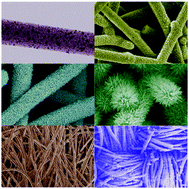One-dimensional metal oxide–carbon hybrid nanostructures for electrochemical energy storage
Abstract
Numerous metal oxides (MOs) have been considered as promising electrode materials for electrochemical energy storage devices, including lithium-ion batteries (LIBs) and electrochemical capacitors (ECs), because of their outstanding features such as high capacity/capacitance, low cost, as well as environmental friendliness. However, one major challenge for MO-based electrodes is the poor cycling stability derived from the large volume variation and intense mechanic strain, which are inevitably generated during repeated charge/discharge processes. Nanostructure engineering has proven to be one of the most effective strategies to improve the electrochemical performance of MO-based electrode materials. Among various nanostructures, one-dimensional (1D) metal oxide–carbon hybrid nanostructures might offer some solution for the challenging issues involved in bulk MO-based electrode materials for energy storage devices. Herein, we give an overview of the rational design, synthesis strategies and electrochemical properties of such 1D MO–carbon structures and highlight some of the latest advances in this niche area. It starts with a brief introduction to the development of nanostructured MO-based electrodes. We will then focus on the advanced synthesis and improved electrochemical performance of 1D MO–carbon nanostructures with different configurations, including MO–carbon composite nanowires, core–shell nanowires and hierarchical nanostructures. Lastly, we give some perspective on the current challenges and possible future research directions in this area.



 Please wait while we load your content...
Please wait while we load your content...